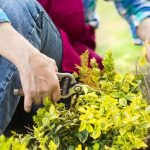Are you looking for gardening ideas for kids to spark their interest and keep them engaged? Gardening is not only a great activity for adults but also for children. It teaches them responsibility, patience, and provides an opportunity to connect with nature. In this article, we will explore the various aspects of gardening that make it an excellent activity for kids, from essential tools and supplies to fun and educational activities.
Gardening provides a hands-on learning experience for kids, allowing them to understand the natural world around them while developing essential life skills. By involving children in gardening, they can learn about the plant life cycle, the importance of nutrition, and the value of hard work. Furthermore, it instills in them a sense of accomplishment as they see their efforts yield beautiful flowers or delicious vegetables.
In addition to being educational, gardening can also be a fun and rewarding experience for kids. From selecting the right plants to creating a child-friendly outdoor space, there are plenty of opportunities to get creative and make gardening an enjoyable activity for children. So let’s dive into the world of kids’ gardening and discover all the wonderful benefits it has to offer.
Getting Started
Gardening is not only a great activity for kids, but it also provides numerous benefits for their physical, mental, and emotional well-being. It teaches them responsibility, patience, and the importance of caring for the environment. In addition, gardening helps children develop an appreciation for nature and healthy eating habits.
When getting started with gardening for kids, it’s essential to have the right tools and supplies to make the experience enjoyable and safe. Child-sized gardening gloves, trowels, watering cans, and rakes are perfect for little hands. Additionally, using lightweight and durable tools will make it easier for kids to handle.
Furthermore, having a dedicated space in the garden or yard where kids can plant and tend to their crops is crucial. Whether it’s a small plot of land or designated containers for plants, creating this space will give children a sense of ownership over their gardening projects. Providing them with their own set of tools will also help build confidence and independence as they work on their garden.
| Essential Tools | Supplies |
|---|---|
| Child-sized gardening gloves | Seeds |
| Trowels | Potting soil |
| Watering cans | Containers (if using) |
Selecting the Right Plants
When it comes to gardening ideas for kids, selecting the right plants is essential to making the experience enjoyable and educational. Choosing easy-to-grow vegetables and flowers will ensure that children can see the fruits of their labor relatively quickly, keeping them engaged and excited about tending to their garden.
Vegetables
One of the best vegetables for kids to grow is carrots. Carrots are easy to grow, and their bright colors and sweet taste make them appealing to children. Radishes are another great option, as they mature quickly, providing kids with a sense of accomplishment. Additionally, cherry tomatoes are perfect for small hands, and their fast growth rate means that kids won’t have to wait long before they can harvest and enjoy them.
Flowers
Choosing flowers that are vibrant and easy to care for can add a pop of color to a child’s garden. Sunflowers are a popular choice because they grow tall quickly and produce large, cheerful blooms. Marigolds are another excellent option as they come in a variety of bright shades and are known for being resilient in various growing conditions. Zinnias also make great choices because of their dazzling array of colors and ability to attract butterflies.
Herbs
Incorporating herbs into a children’s garden can introduce them to new scents and flavors while teaching them about different culinary uses. Herbs like basil, mint, and chives are excellent choices as they are low maintenance and can be used in various recipes or even made into teas or flavored water. By selecting these easy-to-grow plants, parents can introduce children to the joys of gardening while ensuring success in their budding green thumb endeavors.
Fun and Educational Activities
Gardening is not only a great way to introduce kids to the beauty of nature, but it also provides an excellent opportunity to incorporate learning into their daily activities. There are numerous fun and educational activities that can be integrated into gardening for kids, making it an enriching experience for them.
One of the best ways to do this is by turning gardening into a science lesson. Kids can learn about the lifecycle of plants, the importance of sunlight and water, and the role of different insects in the garden ecosystem.
Another gardening activity that can be both fun and educational for kids is maintaining a garden journal. Kids can document their observations, drawings, and notes about the plants they are growing. This helps them develop important skills such as organizing information, critical thinking, and improving their writing abilities. Additionally, gardening provides an excellent opportunity to teach children about responsibility and patience. They will learn that plants require regular care and attention, teaching them valuable life lessons.
Moreover, cooking with the produce from their garden can also be a great way to incorporate learning into gardening for kids. Children can learn about where food comes from, the importance of using fresh ingredients, and how to prepare simple recipes using their homegrown fruits and vegetables. By involving kids in every step of the process – from planting seeds to harvesting fruits – parents can instill in them a love for nature and healthy eating habits.
| Fun Activity | Educational Benefit |
|---|---|
| Maintaining a Garden Journal | Improves critical thinking skills; enhances writing ability |
| Cooking with Garden Produce | Teaches children about food sources; promotes healthy eating habits |
| Science Lessons in Gardening | Learn about plant life cycle; understand importance of sunlight and water |
Creating a Kid-Friendly Garden
Interactive and Playful Features
When designing a garden for kids, it’s important to incorporate interactive and playful features that will engage their senses and imagination. Consider adding a small play area with a sandbox, swing set, or treehouse. You can also include whimsical elements such as colorful stepping stones, fairy gardens, or secret hideaways for children to explore and enjoy.
Education and Exploration Zones
Another key aspect of creating a child-friendly garden is to provide opportunities for education and exploration. Set up designated areas for kids to plant their own flowers or vegetables, allowing them to take ownership of their gardening projects. Incorporate educational elements like identification tags for plants, a mini greenhouse for seed starting, or a butterfly garden to teach kids about pollinators and the natural world around them.
Safety Considerations
When designing a garden for kids, safety should be a top priority. Make sure to eliminate any potential hazards such as thorny plants, poisonous berries, or sharp tools within easy reach. Create clear pathways and boundaries to ensure that children can navigate the garden space safely. Additionally, consider installing child-friendly fencing or gates to keep little ones contained and secure while they explore and play.
By implementing these design tips and ideas, you can create an outdoor space that not only encourages kids to connect with nature but also provides them with a safe and enjoyable environment to learn about gardening. Incorporating these elements into your child-friendly garden will help foster an early love for nature while teaching important life skills through hands-on experiences in the outdoors.
Gardening Safety
When it comes to gardening with kids, safety should always be a top priority. Teaching children about safe practices in the garden not only ensures their well-being but also helps instill important life lessons about responsibility and awareness. Here are some essential gardening safety tips to help kids stay safe while having fun in the garden:
Use Child-Friendly Tools
When introducing kids to gardening, it’s crucial to provide them with tools that are appropriate for their age and size. Look for lightweight and easy-to-handle tools specifically designed for children. This will not only make gardening more enjoyable for them but also reduce the risk of accidents.
Dress for the Occasion
Encourage kids to wear appropriate clothing and gear while gardening. This includes sturdy closed-toe shoes, gloves, and sun protection like wide-brimmed hats or sunscreen. Dressing for the occasion not only protects them from scratches, sunburns, or insect bites but also teaches them the importance of dressing appropriately for different activities.
Teach Proper Plant Handling
It’s important to educate kids about how to handle plants with care to prevent damage or injury. Show them how to gently hold and transplant seedlings, how to avoid overhandling delicate flowers, and which plants may have thorns or prickly leaves that require extra caution.
By implementing these safety practices and instilling a sense of awareness in young gardeners, parents can ensure that the gardening experience remains enjoyable and risk-free for their children. Remember that teaching garden safety is just as important as teaching basic gardening techniques and can help foster a positive relationship with nature that lasts a lifetime.
Harvesting and Enjoying the Fruits of Their Labor
Once kids have successfully grown their own plants and vegetables in the garden, it’s time to teach them about the next step – harvesting and enjoying the fruits of their labor. This is a great opportunity to show children the connection between where food comes from and what ends up on their plates. Here are some creative ideas for turning garden produce into fun snacks and crafts:
- Snack Time: Encourage kids to pick fruits and vegetables from the garden and create their own healthy snacks. They can make fruit kabobs using freshly harvested berries, or create a delicious salad with lettuce, tomatoes, and cucumbers they’ve grown themselves.
- Craft Projects: After harvesting, kids can use natural materials from the garden to create fun craft projects. For example, they can use dried flowers to make colorful pressed flower art, or create leaf prints by painting leaves found in the garden and pressing them onto paper.
By involving kids in the process of harvest and consumption, they learn valuable lessons about sustainability, healthy eating habits, and appreciation for nature’s bounty. These activities also provide opportunities for bonding with family members as they work together in creating delicious snacks or beautiful crafts from their gardening efforts. Overall, turning garden produce into fun snacks and crafts offers a holistic experience that goes beyond simply growing plants.
Sowing the Seeds of a Lifelong Hobby
In conclusion, gardening can have a profound impact on kids, shaping their understanding of nature and teaching them valuable life skills. By introducing children to the joys of gardening at a young age, we can instill in them a love for the outdoors and an appreciation for where their food comes from. As they grow, this early exposure to gardening can lead to a lifelong hobby that brings immense satisfaction and health benefits.
Moreover, the benefits of gardening for kids go beyond just a love for plants and outdoor activities. Gardening teaches responsibility, patience, and the importance of hard work. It also nurtures a sense of accomplishment as kids see the results of their efforts in the form of blooming flowers or fresh fruits and vegetables. These are important life lessons that will serve them well in adulthood.
In today’s digital age, encouraging kids to put down their screens and engage in hands-on activities like gardening is more important than ever. Through gardening, children can connect with nature, learn about the environment, and develop a sense of stewardship for the planet. So let’s continue to explore creative ways to introduce gardening ideas for kids and help them cultivate a lifelong passion for this rewarding hobby.

Welcome to my gardening blog! I am passionate about plants and enjoy sharing my knowledge and experiences with others. In this blog, I will write about everything related to gardening, from tips on how to get started to updates on my own garden projects.





